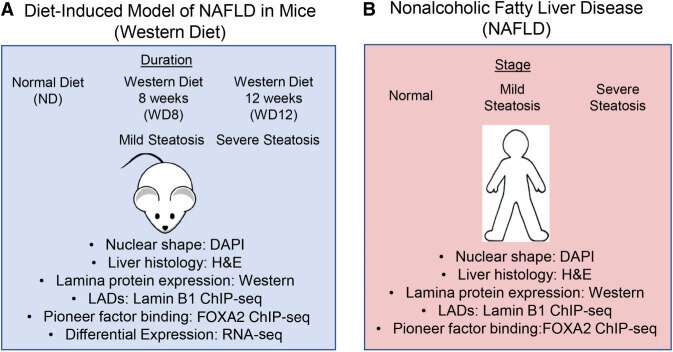This article has been reviewed according to Science X's editorial process and policies. Editors have highlighted the following attributes while ensuring the content's credibility:
fact-checked
peer-reviewed publication
trusted source
proofread
Trigger for world's most common liver disease identified

University of Virginia School of Medicine researchers have discovered a key trigger for non-alcoholic fatty liver disease, a mysterious condition that causes fat to build up in the liver for no clear reason. The new insights help explain the condition in younger people and could lead to the first treatment for the most common liver disease in the world.
The culprit? Wrinkles forming in the cellular compartment that contains our DNA. Prior research by the UVA scientists suggested that these wrinkly cellular nuclei could be involved in common metabolic diseases such as diabetes and fatty liver disease and even aging itself. The new results bolster those findings and could lead to treatments targeting the wrinkles to stop fatty liver disease—and possibly slow or reverse aging.
"We found a common mechanism involving the nucleus and the nuclear lamina that leads to fat accumulation in the liver in aged individuals and younger people with non-alcoholic fatty liver disease," said senior researcher Irina M. Bochkis, Ph.D., of UVA's Department of Pharmacology. "Our findings could lead to novel treatments aimed at restoring the function of the nuclear lamina to control aberrant genes and reverse fatty liver in young patients with non-alcoholic fatty liver disease or aged individuals."
Understanding non-alcoholic fatty liver disease
Fatty liver disease is common among people who consume large amounts of alcohol—the excess storage of fat in the liver is a red flag that a person is drinking heavily. But non-alcoholic fatty liver disease strikes people who drink little or not at all, especially older people and people with type 2 diabetes. Approximately 40% of people over age 70 have the condition.
For many people, fatty liver disease causes no symptoms. They may not even be aware they have it. But for others, it can cause weakness, fatigue and abdominal pain, diminishing quality of life. Unfortunately, there is no treatment.
Doctors have struggled to understand what triggers non-alcoholic fatty liver disease, but UVA's new discovery suggests it may be caused, at least in part, by malfunctions inside the "hard drives" that contain our cells' operating instructions. These changes start within the cell nucleus, where our chromosomes are stored, and alter the activity of certain genes—ultimately leading to fat accumulation in the liver.
The new research suggests the fault begins in a portion of the nucleus called the lamina. The lamina acts as a tether between the nuclear membrane and genetic material contained within, called chromatin. The formation of wrinkles in the lamina, Bochkis and her team found, affects the activity of genes that control the storage of fats. When these genes become hyperactive, the liver becomes stuffed with excess fats, leading to non-alcoholic fatty liver disease.
To verify their findings, the researchers looked at liver cells collected from younger human patients, ages 21-51, with non-alcoholic fatty liver disease. The scientists found exactly what they expected: wrinkly lamina. This helps explain why the condition can strike people of any age, the researchers say, and should be useful for identifying those at risk.
By targeting the harmful changes in the lamina, researchers may be able to develop ways to treat or even prevent non-alcoholic fatty liver disease (and possibly other metabolic diseases and even aging). For example, Bochkis has said scientists might be able to use custom-tailored viruses to deliver different lamin proteins to the liver to smooth the membranes' surfaces and restore the cells to proper function.
"Currently there is no treatment for non-alcoholic fatty liver disease and no method to stratify the patients," Bochkis said. "Our findings could lead to improved stratification and a novel treatment without side effects where restoring the lamina function returns the cell to a healthy state with appropriate gene expression."
The study is published in the journal Genome Research.
More information: Xiaolong Wei et al, Redistribution of lamina-associated domains reshapes binding of pioneer factor FOXA2 in development of nonalcoholic fatty liver disease, Genome Research (2022). DOI: 10.1101/gr.277149.122



















